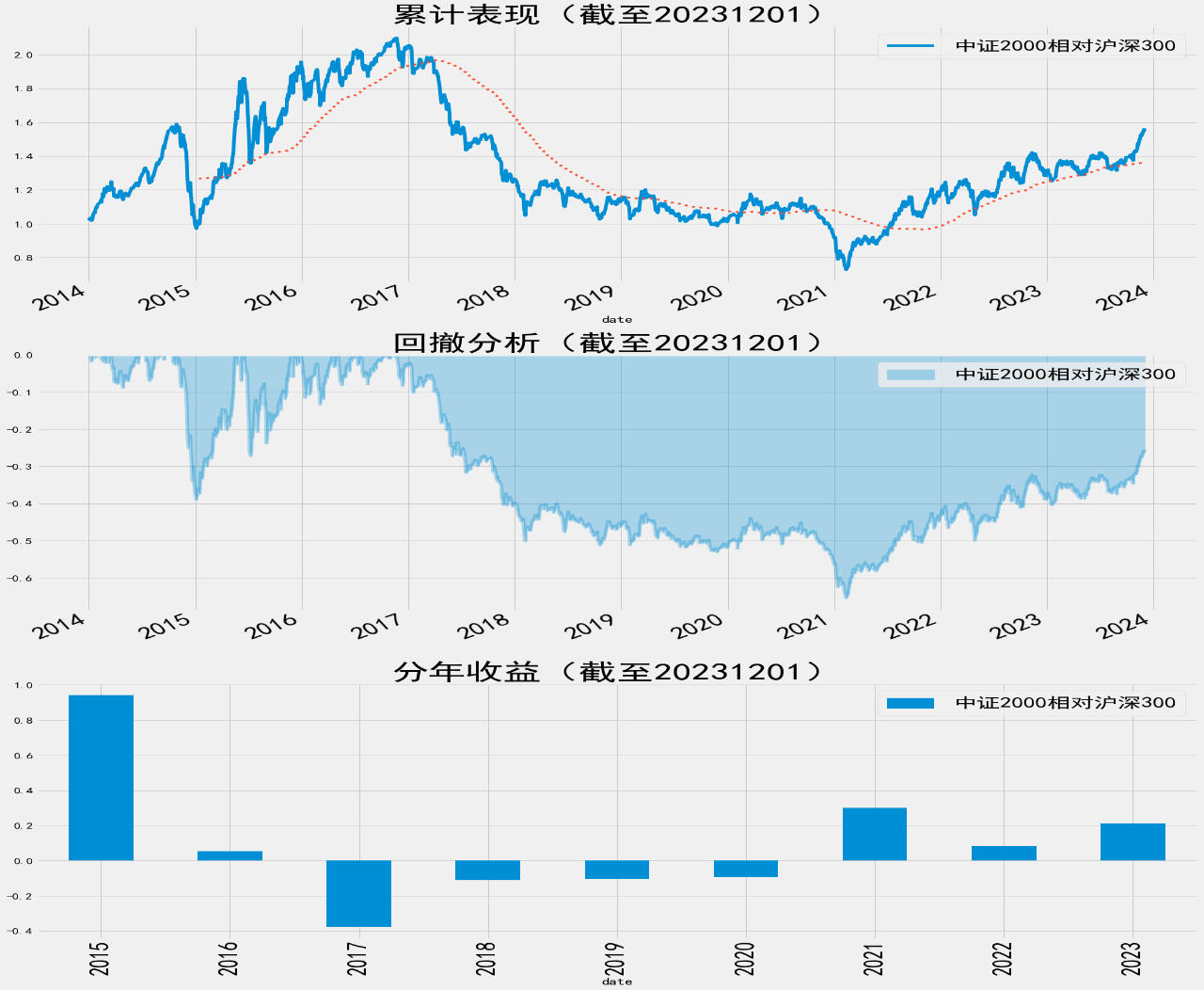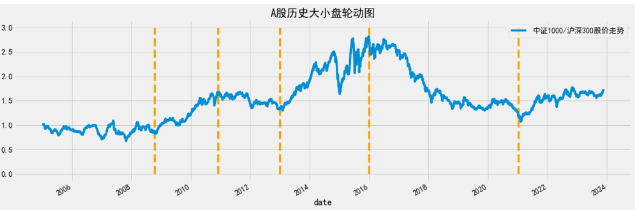WE THINK – How to look at the surge of small caps and Beijing Stock Exchange Frenzy
In November, small-cap stocks remained the dominant theme in the A-share market. The performance of the main board and blue-chip stocks was weak, with the Shanghai and Shenzhen 300 Index falling by 2.14% for the entire month, while the CSI 2000 Index rose by 5%. The popularity of small-cap stocks began to spread from the Shanghai and Shenzhen Stock Exchanges to the Beijing Stock Exchange, where investors discovered smaller market capitalizations and lower trading volumes, requiring less capital to drive price increases. The Beijing Stock Excahnge 50 Index surged by 27.54% in November, with a peak increase of 50.04% at one point during the month. Trading volume and turnover ratio rapidly expanded in the short term. However, at the end of the month, regulatory authorities intervened to cool down and suppress speculative trading, and factors such as shareholder reductions in some companies listed on the Beijing Stock Exchange affected the Beixing 50 Index. As a result, the index has experienced a retracement of 17.2% in the past four trading days. Investors who bought at high prices have suffered some losses.
People have generally noticed that institutional heavyweight stocks and blue-chip stocks have been performing weaker compared to small-cap companies this year. The smaller the market capitalization, the stronger the performance of the company. The Wande Micro-Cap Index has risen by 47.88% year-to-date, while the Beijing 50 Index increased by 27% in November. In this issue, we will discuss how to interpret the phenomenon of the underperformance of high-quality blue-chip stocks, the strength of small-cap stocks, and the speculative frenzy surrounding the Beijing 50 Index.
The rotation of market styles is actually a pattern of market cycles
In fact, the underperformance of institutional heavyweight stocks and blue-chip stocks compared to small-cap companies in this cycle began in 2021. From 2017 to 2020, representing the large-cap stocks, the Shanghai and Shenzhen 300 Index outperformed both the CSI 1000 Index representing small-cap stocks and the CSI 2000 Index representing micro-cap stocks in each year. After four years of dominance by large-cap stocks, the market shifted to a small-cap dominance style in 2021, 2022, and 2023. During these three years, both the CSI 1000 Index and the CSI 2000 Index outperformed the Shanghai and Shenzhen 300 Index.

Why does the rotation of styles occur? The reason is quite simple. If a particular style continues to perform strongly for a long time, its valuation will continuously increase. However, when the runway becomes overcrowded and valuations become too high, early investors who have made substantial profits naturally start considering taking profits and looking for the next opportunity. The same principle applies to underperforming sectors. After a few years of poor performance, valuations naturally become cheaper, and their relative attractiveness becomes more evident. When some long-term investors recognize the investment value and continuously allocate funds to these relatively weak sectors, they may experience a new cycle of growth and prosperity.
The end of 2020 and the beginning of 2021 marked such a transitional period. Since 2017, with the gradual increase in foreign capital flowing into the A-share market and the acceleration of domestic institutionalization of investors, industry leaders with solid fundamentals and clear business models, as well as high-quality blue-chip stocks, gradually gained strength. This type of investment style also delivered decent absolute and relative returns, attracting continuous inflows of funds into these stocks and funds. At the same time, the blue-chip sector also attracted funds from other sectors in the market. Due to the consensus and participation of various funds, the valuations of core assets at the beginning of 2021 indeed experienced a significant level of bubble formation. The valuations of small and micro-cap stocks, which had their funds siphoned off, compressed to relatively cheaper levels. Subsequently, as blue-chip and large-cap companies temporarily lacked earnings momentum, funds began to gradually flow out of this area in pursuit of new opportunities.
It is a well-established fact that small-cap stocks have outperformed large-cap stocks in the past two years, including this year. The key question now is: how long will this situation of small-cap strength and large-cap weakness continue? Should investors sell large-cap stocks and buy small-cap stocks? In fact, this question itself is a trap. For investors with various investment styles in the market, those who primarily consider fundamental factors do not necessarily differentiate companies based on market capitalization. The categorization of companies based on market cap is often the language of trend investors. Let's return to the method of trend investing to explore at which stage this style of large-cap weakness and small-cap strength currently stands. Is it in the early stage, middle stage, or late stage?

Historically, the rotation between large-cap and small-cap styles has shown cyclical patterns. The current trend of small-cap outperformance has lasted for nearly three years. Attempting to predict the exact day when the trend will reverse is inherently unpredictable and not scientifically achievable. However, considering the recent discussions in various media and social media platforms about the outstanding performance of small-cap stock indices and the growing enthusiasm for trading small-cap stocks on the Beijing Stock Exchange, it seems that we are not in the early or middle stages of a market cycle. For non-professional short-term traders who have missed the early stages of the trend, it might be prudent to exercise caution. After all, one of the easiest ways to lose money is to chase high and participate in a style that has already gained significant market recognition.
How to view the recent hype around the Beijing Stock Exchange
The recent hype around the Beijing Stock exchange has attracted significant attention. Prior to this month, the Beijing Stock exchange had not received much interest from institutional and individual investors, and it had low trading volume and liquidity. However, in recent times, regulatory measures and policies have been implemented to actively promote the Beijing Stock exchange, with the intention of developing it into an important domestic exchange similar to the Shanghai and Shenzhen stock exchanges. Despite the market's initial lack of attention, the recent surge in small-cap stock trading, coupled with efforts by sellers to encourage investors who already have access to the STAR Market and Hong Kong Stock Connect to gain trading access to the Beijing Stock exchange, has increased its visibility. The rise of the Beijing Stock 50 Index has gradually attracted market attention. Particularly in the past week, the reflexive nature of the market's rally has led to an influx of funds and short-term price surges. As institutional investors, how should we view and participate in investments on the Beijing Stock Exchange?
Our team recently reviewed the companies listed on the Beijing Stock 50 Index. Overall, most of these companies hold positions outside the top five in their respective industries, and their revenue scale and competitive advantages in the industry may not be very prominent. However, in terms of valuation, they are not considered expensive either. There are also some companies with higher industry positions. Each institution may have a different attitude towards the companies listed on the Beijing Stock exchange. Our approach is to not discriminate against or idolize good companies listed on the Beijing Stock exchange, but rather to give them due attention. We will include excellent companies from the Beijing Stock exchange in our research and coverage, just as we treat outstanding companies listed on the Shanghai, Shenzhen, and Hong Kong exchanges. Investors may need to gradually adapt to the investment ecosystem of having four securities exchanges in China - Shanghai, Shenzhen, Hong Kong, and Beijing. However, it should be noted that the inclusion of the Hong Kong Stock Exchange and Beijing Stock exchange in the investment landscape is, in a sense, an expansion of the A-share market. This may also be one of the reasons why stabilizing and invigorating the capital market is more challenging than before.
Recent Investment Strategies
There have been no significant changes compared to the previous period. We continue to adhere to our investment strategy of navigating the volatility of the spring market, patiently optimizing and adjusting our portfolio, and focusing on long-term quality companies that are trading at reasonable or undervalued levels.
In spring, it is normal to experience some market fluctuations and adjustments. Investors who remain committed to the equity market during this period may need to endure some short-term pain. However, the experiences from multiple market cycles have taught us that enduring the challenges of the spring market is a short-term discomfort but a long-term correct decision.
Best Regards,
WU Weizhi
Dec 3rd 2023
本期《偉志思考》簡體中文版鏈接:
伟志思考:如何看待热炒小市值公司和北交所热潮
WE THINK: The Market is Developing Amidst Hesitations
"Buy a little during the trough with a compassionate heart, and step back when everyone is scrambling!" Perhaps the results of investment and financia
2024-04-01WE THINK: Is the Bear Market Over?
Our view of the market is also very clear: the systematic decline in the bear market has ended! However, the end of the bear market and the start of a
2024-03-04WE THINK | Why Did the Stock Market Accelerate Its Decline in January? How Far Is Spring Away?
"The bear market gestates in frenzy, takes shape in uncertainty, develops in numbness, matures in pessimism, and ends in despair."
2024-02-052024 Outlook:Is 2024 going to be better? Or not?
The bad news is that the stock market has been in a bear market for three consecutive years and many people have lost a significant amount of money. T
2024-01-10